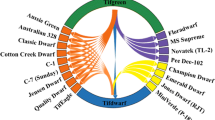Abstract
Switchgrass (Panicum virgatum L.) is a naturally allogamous species. Recent studies indicated conditional self-compatibility exists in the species and can be used to produce inbreds for the exploitation of heterosis in biomass production. However, efficient and reliable bagging methods are unavailable for development of inbreeding. This study was designed to determine the efficacy of a polyester bagging method in blocking extraneous pollen such that switchgrass may self more efficiently. In this experiment four northern lowland (NL) inbreds, four NL non-inbreds, two southern lowland (SL) non-inbreds and 16 upland-lowland (interecotypic) F1 hybrids were self-pollinated by enclosing their inflorescences in polyester bags in the field; bags were also placed on 14 F1 interecotypic hybrid plants potted in a greenhouse. The reliability of the bags was determined using eight to ten simple sequence repeat (SSR) markers that distinguished the genetic parentage of the pollen. Contaminants were identified in two groups: outcrossing contaminants (OCs) and physical contaminants (PCs) based on the amplified alleles of their progeny and their seed parents. Of 39 polyester bags field tested in 2012, 35 bags showed 100 % selfed progeny, four showed PCs; no OCs were identified. Similarly, of 61 bags tested in 2013 in two field plots, 50 bags produced 100 % selfed progeny, while four bags produced OCs, five produced PCs and the other two produced both OCs and PCs. No contaminants were identified from the progeny of 18 bags used in the greenhouse, suggesting that high wind speed, physical damage or handling errors may have resulted in the contaminations of bagged progeny in the field. The result of this experiment establishes the increased reliability of the polyester bagging method over previously tested methods for selfing switchgrass under field and greenhouse conditions. Additionally, the S1, S2 and S3 inbreds produced in this study will contribute to developing completely or near completely homozygous inbred lines in the future.



Similar content being viewed by others
References
Sanderson MA, Reed RL, McLaughlin SB, Wullschleger SD, Conger BV, Parrish DJ, Wolf DD, Taliaferro C, Hopkins AA, Ocumpaugh WR, Hussey MA, Read JC, Tischler CR (1996) Switchgrass as a sustainable bioenergy crop. Bioresour Technol 56:83–93. doi:10.1016/0960-8524(95)00176-X
Porter CL Jr (1966) An analysis of variation between upland and lowland switchgrass, Panicum Virgatum L., in central Oklahoma. Ecology 47:980–992. doi:10.2307/1935646
Martínez-Reyna JM, Vogel KP (2002) Incompatibility systems in switchgrass. Crop Sci 42:1800–1805. doi:10.2135/cropsci2002.1800
Thomson AM, Izaurralde RC, West T, Parrish DJ, Tyler DD, Williams JR (2009) Simulating potential switchgrass production in the United States. Pacific Northwest National Laboratory Richland, WA
Martinez-Reyna JM. Vogel KP (2008) Heterosis in switchgrass: spaced plants. Crop Sci., vol 48. doi:10.2135/cropsci2007.12.0695
Vogel KP, Mitchell RB (2008) Heterosis in switchgrass: biomass yield in swards. Crop Sci 48:2159–2164. doi:10.2135/cropsci2008.02.0117
Schmer MR, Vogel KP, Mitchell RB, Perrin RK (2008) Net energy of cellulosic ethanol from switchgrass. Proc Natl Acad Sci U S A 105:464–469. doi:10.1073/pnas.0704767105
Casler M (2012) Switchgrass breeding, genetics, and genomics. In: Monti A (ed) Switchgrass. Green Energy and Technology, Springer London, pp 29–53. doi:10.1007/978-1-4471-2903-5_2
Jones MD, Brown JG (1951) Pollination cycles of some grasses in Oklahoma. Agron J 43:218–222. doi:10.2134/agronj1951.00021962004300050003x
Liu L. Wu Y (2012) Identification of a selfing compatible genotype and mode of inheritance in switchgrass. BioEnergy Research, vol 5. Springer-Verlag. doi:10.1007/s12155-011-9173-z
Liu L. Thames S. Wu Y (2013) Lowland switchgrass plants in populations set completely outcrossed seeds under field conditions as assessed with ssr markers. Bioenerg Res:1–7. doi:10.1007/s12155-013-9367-7
Liu L, Wu Y (2012) Development of a genome-wide multiple duplex-SSR protocol and its applications for the identification of selfed progeny in switchgrass. BMC Genomics 13:1–13. doi:10.1186/1471-2164-13-522
Wang Z-Y, Ge Y, Scott M, Spangenberg G (2004) Viability and longevity of pollen from transgenic and nontransgenic tall fescue (Festuca arundinacea)(Poaceae) plants. Am J Bot 91:523–530
Ge Y, Fu C, Bhandari H, Bouton J, Brummer EC, Wang Z-Y (2011) Pollen viability and longevity of switchgrass (L.). Crop Sci 51:2698–2705
Ecker G, Meyer T, Auer C (2013) Pollen longevity and dispersion models for switchgrass. Crop Sci 53:1120–1127. doi:10.2135/cropsci2012.06.0382
McAdam NJ, Senior J, Hayward MD (1987) Testing the efficiency of pollination bag materials. Plant Breed 98:178–180
pbsinternational why our bags are best http://www.pbsinternational.com/our-products/. Accessed 3/2 2014
Todd J ((2011).) Study of the diversity, inbreeding potential, and sward heritability of switchgrass. ProQuest dissertations and theses 147. Retrieved from http://search.proquest.com/docview/926208151?accountid=4117. (926208151). (Order No. 3498112, Oklahoma State University)
Vogel K. Sarath G. Mitchell R (2014) Micro-mesh fabric pollination bags for switchgrass. Crop Sci. doi:10.2135/cropsci2013.09.064
Wang YW, Samuels TD, Wu YQ (2011) Development of 1,030 genomic SSR markers in switchgrass. Theor Appl Genet 122:677–686. doi:10.1007/s00122-010-1477-4
Bhandari H. Saha M. Bouton J (2010) Genetic variation in lowland switchgrass (Panicum virgatum L.). In: Huyghe C (ed) Sustainable use of genetic diversity in forage and turf breeding. Springer Netherlands, pp 67–71. doi:10.1007/978-90-481-8706-5_7
Okada M, Lanzatella C, Tobias C (2011) Single-locus EST-SSR markers for characterization of population genetic diversity and structure across ploidy levels in switchgrass (Panicum virgatum L.). Genet Resour Crop Evol 58:919–931. doi:10.1007/s10722-010-9631-z
Mesonet (2012) Mesonet climatological data summary. http://www.mesonet.org/common/db/library/functions/mcd/mcd.php?ver=2&year=2012&month=9&format=pdf&stid=STIL. Accessed 6/27 2013
Acknowledgments
The research was supported by the NSF EPSCoR award EPS 0814361, the DOT-DOE Sun Grant Initiative award DTOS59-07-T-00053, YQW Hatch funds and the Oklahoma Agricultural Experiment Station. Thanks go to Pu Feng, Shiva Makaju, Gary Williams, Seth Davis and Ethane Purkins for their technical help in both the field and greenhouse, to Linglong Liu, Tilin Fang and Tim Samuels for their help in the laboratory, and to Dr. Ulrich Melcher for editing of the manuscript.
Author information
Authors and Affiliations
Corresponding author
Rights and permissions
About this article
Cite this article
Adhikari, L., Anderson, M.P., Klatt, A. et al. Testing the Efficacy of a Polyester Bagging Method for Selfing Switchgrass. Bioenerg. Res. 8, 380–387 (2015). https://doi.org/10.1007/s12155-014-9528-3
Published:
Issue Date:
DOI: https://doi.org/10.1007/s12155-014-9528-3




